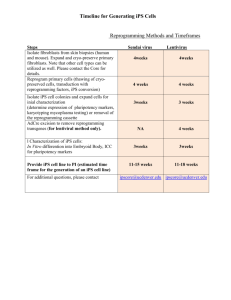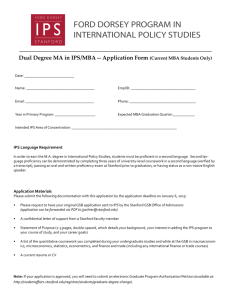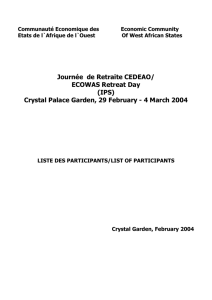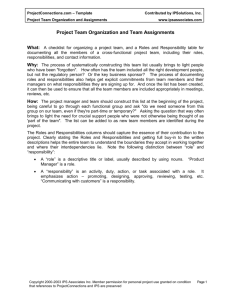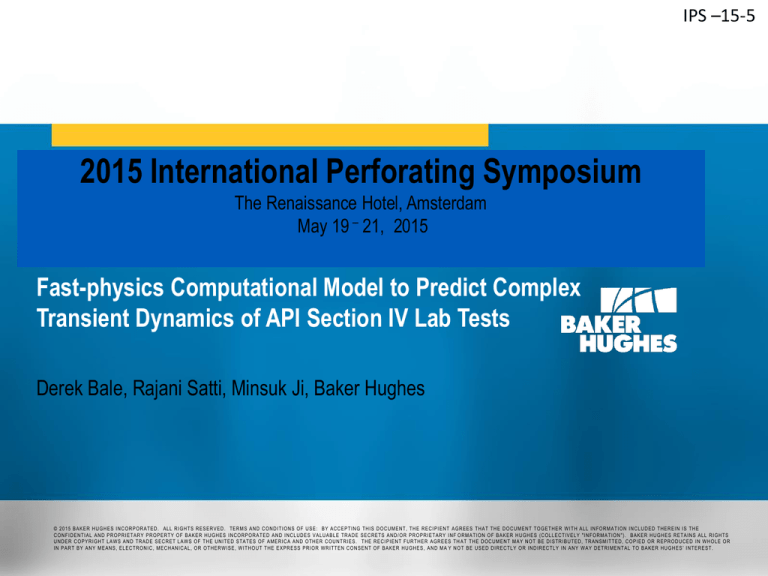
IPS –15-5
2015 International Perforating Symposium
The Renaissance Hotel, Amsterdam
May 19 – 21, 2015
Fast-physics Computational Model to Predict Complex
Transient Dynamics of API Section IV Lab Tests
© 2014 Baker Hughes Incorporated. All Rights
Reserved.
Derek Bale, Rajani Satti, Minsuk Ji, Baker Hughes
1
© 2015 BAKER HUGHES I NCORPORATED. ALL RI GHTS RESERVED. TERM S AND CONDI TI ONS OF USE: BY ACCEPTI NG THI S DOCUM ENT, THE RECI PI ENT AGREES THAT THE DOCUM ENT TOGETHER W I TH ALL I NFORM ATI ON I NCLUDED THEREI N I S THE
CONFI DENTI AL AND PROPRI ETARY PROPERTY OF BAKER HUGHES I NCORPORATED AND I NCLUDES VALUABLE TRADE SECRETS AND/ OR PROPRI ETARY I NF OR M ATI ON OF BAKER HUGHES (COLLECTI VELY "I NFORM ATI ON"). BAKER HUGHES RETAI NS ALL RI GHTS
UNDER COPYRI GHT LAW S AND TRADE SECRET LAW S OF THE UNI TED STATES OF AM ERI CA AND OTHER COUNTRI ES. THE RECI PI ENT FURTHER AGREES TH AT THE DOCUM ENT M AY NOT BE DI STRI BUTED, TRANSM I TTED, COPI ED OR REPRODUCED I N W HOLE OR
I N PART BY ANY M EANS, ELECTRONI C, M ECHANI CAL, OR OTHERW I SE, W I THOUT THE EXPRESS PRI OR W RI TTEN CONSENT OF BAKER HUGHES, AND M A Y N OT BE USED DI RECTLY OR I NDI RECTLY I N ANY W AY DETRI M ENTAL TO BAKER HUGHES’ I NTEREST.
Overview of the Presentation
Introduction
Perforation flow laboratory
Existing laboratory event modeling
Objectives
Our design philosophy
Fast-physics: Model and results
Fast-physics: Plans for future
Conclusions
IPS – 15-5
Introduction
Next-generation well completions
–High-pressure/high-temperature
–Ultra-deepwater
–Long horizontals
Understanding the transient fluid dynamics during the
perforating process is critical to perforating well design.
Transient dynamics influenced by
job design parameters:
–Gun design
–Formation properties
–Under/Overbalance conditions
IPS-15-5
IPS –15-5
Perforation Flow Laboratory
Flow laboratory: Clear vehicle to study
and understand the coupled effects
between transient dynamics and job
design parameters.
Measurements from a Section-IV test:
Pre- and post-flow permeability
Core flow efficiency
Productivity
Dynamic high-speed pressure
Perforation tunnel characteristics
Clean-up and underbalance
optimization
IPS –15-5
Perforation Flow Laboratory
The dynamic pressure data provides insight into
the perforation process.
Though the details of the pressure curve look
complicated, the general trends of the dynamics
are dominated by only a few physical processes.
Wellbore Pressure (psi)
Challenges:
• Experimental costs
• Limited data
• Impractical when DOEs are required
reservoir
wellbore
High-Speed Gauge Data
IPS –15-5
Laboratory Event Modeling
Laboratory simulator:
– Useful tool to aid in experimental data
analysis and interpretation
– Helps in planning and optimizing
experiments
– Can reduce the size of meaningful
DOEs (saves $$$)
– Modeling can be upscaled to field-scale
analysis (improves perforating jobs)
wellbore
Simulation (wellbore)
Simulation (reservoir)
Pressure (PSI)
Existing models:
1. Limitations in representing
flow lab geometry
2. Too many “free parameters”
unrelated to the flow
physics
3. A decent fit requires
multiple ~30 min. runs for
tuning
reservoir
High-Speed Gauge Data
Time (s)
Objectives of the Study
IPS –15-5
Understand and analyze the complex transient dynamics
obtained from an API Section-IV experiment.
Develop one-of-its-kind fast computational model based
on simplified dominant processes that play an important
role during the Section-IV test.
Predict the complex pressure transients that are
generated using a dynamic perforating event.
Our Design Philosophy
IPS –15-5
Presented in
IPS –15-19
Fast Physics: Model Development
IPS –15-5
We used four major development steps to create this simulation tool :
Conceptual
Full
Numerical
Fast Physics
Proof of
Concept
• Simple shape of the pressure transients hint at two dominant physical processes
• Test of time scales as rough estimators.
• Develop full models for gun, wellbore, and reservoir.
• Implement them in a bench-top environment.
• Use full numerical simulation to understand dominant processes.
• Recast full model into simplified “dominant physics” model.
• Comparison of measured pressure transients with computed values.
Fast-Physics: Model Components
•
•
•
•
•
Wellbore
Gun chamber
Rock core
Connectivity to accumulators
Perforation tunnel
IPS –15-5
Fast-Physics: Model Assumptions
• Wellbore
1. Weakly compressible
2. Isothermal
3. Inviscid flow
• Gun Chamber
1. Compressible ideal gas
2. Gas expansion is adiabatic
3. Initially at atmospheric pressure
• Rock Core
1. Uniform porous medium
2. Linear Darcy flow
3. Weakly compressible liquid (incompressible rock)
4. Pore pressure greater than wellbore
IPS –15-5
Fast-Physics: Preliminary Results
IPS –15-5
Model fit to measurement
data is very good.
No parameter “fudging”, all
parameters are physicsbased and their values lend
insight into the physical flow
Each run takes <100 ms to
run a fitting tool will be
simple and feasible
Efficient tool to understand
- underbalance conditions
- overbalance conditions
- influence of damage zones
- clean up dynamics
Fast-Physics: Preliminary Parametric Analysis
Gun
geometry (volume)
gas constant
external conditions
shape charge characteristics
Wellbore
fluid properties (compressibility)
geometry (volume)
initial state (static underbalance)
Rock Core
permeability (volume and non-uniformity)
Porosity
Viscosity
An example of modifying
permeability
Fast-Physics: Future Plans
Preliminary fast-physics model
Model perforation tunnel geometry
Model damage zones
Burn models
Detailed validation using gauge/CFD
data
Integrate clean-up model with fast-physics
Upscale results to existing
field-scale simulator
Fundamental investigation of
perforation dynamics: CFD
CFD models: crushed zone,
exact tunnel geometries
Conclusions
• A new model and simulation tool has been developed for interpretation of the
pressure transients of an API-RP 19B Section IV flow test.
– Model is based on simplified dominant physics
– Each simulation runs in < 1 second
– Its simple form enables interpretation based directly on physical parameters.
• Preliminary results show good agreement between measured high-speed data and
computed dynamic pressure data.
• As part of our future plans, we are working on
– Extending the fast-physics to include details effects of perforation
tunnel characteristics (true size/shape and crushed zone)
– Comprehensive validation using gauge and CFD data
– Incorporate clean-up and upscaling models
Slide 16
IPS – 15 - 5
Acknowledgements / Thank You
© 2014 Baker Hughes Incorporated. All Rights
Reserved.
Committee of the 2015 IPS Europe
16
© 2014 Baker Hughes Incorporated. All Rights
Reserved.
Slide 17
IPS – 15 - 5
Questions ?
17


